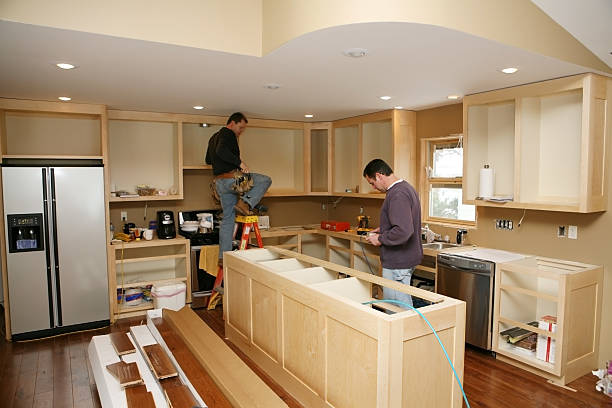
Embarking on a kitchen remodel is an exciting yet challenging endeavor for many homeowners. It’s a project filled with potential, promising a fresh and functional space for cooking and gathering. However, one of the most critical aspects of this journey is understanding and estimating the costs involved. In this comprehensive guide, we will delve into the step-by-step process of estimating the cost of a kitchen remodel, considering various factors that impact expenses, and exploring valuable resources to guide you through this transformative journey.
Importance of Estimating
Value of a Kitchen Remodel
A kitchen remodel is not just about enhancing the aesthetics of your home; it also adds substantial value. It’s one of the most sought-after features for potential buyers, making it a worthwhile investment. Studies have shown that a well-executed kitchen renovation can yield a high return on investment (ROI), often ranging from 70% to 80% of the project’s cost.
Benefits of Proper Estimation
Properly estimating the cost of your kitchen remodel is crucial for several reasons:
- Realistic Budgeting: Understanding the potential expenses helps you create a realistic budget that aligns with your financial capabilities.
- Avoiding Surprises: Detailed estimates help you anticipate and plan for any unexpected costs that may arise during the project.
- Maximizing Value: By knowing the costs upfront, you can make informed decisions on where to allocate your budget to achieve the best results.
Factors Affecting Costs
Kitchen Size
The size of your kitchen is a fundamental factor in determining the overall cost of the remodel. Larger kitchens naturally require more materials, increased labor, and potentially more complex installations. A kitchen with ample space may allow for additional features such as islands, extended countertops, or more extensive cabinetry, all of which contribute to higher costs.
Quality of Materials
The materials you choose for your kitchen remodel have a significant impact on the overall expenses. While it’s tempting to opt for the most luxurious options, it’s essential to balance quality with your budget. Here are some common materials and their price ranges:
- Countertops: Prices can vary widely, from affordable laminate options to high-end granite or quartz.
- Cabinetry: Ready-to-assemble (RTA) cabinets are more budget-friendly, while custom cabinets come at a premium.
- Flooring: Choices range from cost-effective vinyl or laminate to upscale hardwood or natural stone.
Labor Costs
Labor costs encompass the fees charged by contractors, carpenters, plumbers, electricians, and other professionals involved in the remodel. These costs can vary significantly based on:
- Location: Urban areas often have higher labor rates than rural regions.
- Experience: Highly skilled professionals may charge more for their expertise.
- Scope of Work: Complex projects, such as moving plumbing or rewiring electrical systems, require more labor and thus incur higher costs.
Design Complexity
The complexity of your kitchen design directly influences the overall cost. A straightforward layout with standard cabinets and appliances will be more affordable than a custom-designed kitchen with intricate features such as:
- Custom Cabinetry: Made-to-order cabinets designed to fit unique spaces or accommodate specific storage needs.
- Specialty Appliances: High-end appliances with advanced features or custom finishes.
- Architectural Changes: Structural modifications, such as removing walls or expanding the kitchen footprint.
Geographic Location
Believe it or not, your geographic location can significantly impact the cost of your kitchen remodel. Prices for materials, labor, and permits can vary widely between states or even within the same city. Urban areas tend to have higher costs due to increased demand and operating expenses.
Steps to Estimate Costs
1. Assessing Your Needs
Before diving into the specifics of costs, take the time to assess your needs and priorities for the remodel. Consider factors such as:
- Functionality: What are the essential functions your kitchen must serve? Do you need more storage, counter space, or improved workflow?
- Aesthetics: What style do you envision for your new kitchen? Modern, traditional, farmhouse, or something entirely unique?
- Budget: Establish a clear budget range based on your financial situation and the scope of work you wish to undertake.
2. Researching Material Costs
Knowledge is power when it comes to estimating material costs. Take the time to research:
- Price Ranges: Look up the average costs of materials such as countertops, flooring, cabinetry, appliances, and fixtures.
- Quality Levels: Understand the differences in quality within each material category. For example, laminate countertops vary widely in price and durability.
3. Obtaining Quotes
Gather detailed quotes from multiple contractors or remodeling companies. A comprehensive quote should include:
- Material Breakdown: Clear listing of materials to be used, including brand names and specific models if applicable.
- Labor Costs: Hourly rates or project-based fees for each aspect of the remodel, from demolition to installation.
- Timeline: Estimated start and completion dates for the project, including any potential delays.
4. Considering Labor Costs
When estimating labor costs, it’s essential to consider:
- Hourly Rates: Understand the typical rates for various professionals in your area.
- Scope of Work: Detailed tasks involved in the remodel, such as plumbing, electrical work, carpentry, and installation.
- Permits and Inspections: Factor in the costs associated with obtaining necessary permits and scheduling inspections.
5. Contingency Planning
No matter how well you plan, unexpected surprises can arise during a remodel. Allocate a contingency fund of 10% to 20% of your total budget to:
- Unforeseen Issues: Structural problems, hidden water damage, or electrical complications.
- Change Orders: Adjustments to the original plan or unexpected additions based on evolving needs.
Tools and Resources
Estimating Software
Utilize specialized software tools designed for home remodeling estimates. These programs offer:
- Detailed Estimates: Create itemized lists of materials and labor costs for accurate budgeting.
- Visualizations: Generate 3D renderings or floor plans to visualize the proposed changes.
- Budget Tracking: Monitor expenses throughout the project to stay on target.
Online Cost Calculators
For a quick and rough estimate, online cost calculators can be invaluable. These tools allow you to:
- Input Data: Enter details such as square footage, desired materials, and project scope.
- Receive Estimates: Get instant estimates for materials, labor, and total project costs.
- Compare Options: Experiment with different scenarios to find the best balance of cost and quality.
Contractor Consultations
Don’t hesitate to reach out to remodeling professionals for guidance. Many contractors offer:
- Free Consultations: Discuss your project goals, budget, and timeline with experienced professionals.
- Portfolio Reviews: View past projects to get an idea of the contractor’s style and craftsmanship.
- Recommendations: Receive expert advice on materials, design options, and cost-saving measures.
Hiring Professional Services
Contractor Selection
Choosing the right contractor is crucial to the success of your kitchen remodel. Consider the following when making your selection:
- Reputation: Look for contractors with positive reviews, referrals from friends or family, or memberships in professional associations.
- Portfolio: Review examples of their past work to ensure their style aligns with your vision.
- Licensing and Insurance: Verify that the contractor is licensed, bonded, and insured to protect yourself against liability.
Estimating Services
Some homeowners opt to hire professional estimators to handle the cost assessment process. These services offer:
- Accuracy: Experienced estimators can provide precise cost breakdowns based on industry standards.
- Negotiation Support: Use estimates as leverage when negotiating with contractors or suppliers.
- Peace of Mind: Avoid the stress of trying to calculate costs yourself and rely on expert guidance.
Need expert guidance on estimating the cost of your dream kitchen remodel? Explore the realm of Residential Estimating Services to turn your vision into a tangible budget plan.
Budgeting Tips
Set Priorities
Determine which aspects of the remodel are non-negotiable for you. Allocate a larger portion of your budget to high-priority items such as:
- Quality Appliances: Invest in energy-efficient, durable appliances that will last for years.
- Custom Features: Splurge on unique elements that add personality and functionality to your kitchen.
Shop Smart
Stretch your budget further by:
- Comparing Prices: Don’t settle for the first quote you receive. Shop around and negotiate for the best deals.
- Seasonal Sales: Take advantage of seasonal promotions or clearance sales to score discounts on materials or appliances.
DIY vs. Professional
While some tasks are best left to professionals, there are opportunities for DIY savings:
- Painting: Refresh your kitchen’s look with a fresh coat of paint on walls or cabinets.
- Minor Repairs: Fixing small issues like leaky faucets or loose cabinet handles can save on service calls.
Phased Approach
If your budget is tight, consider breaking the remodel into phases:
- Priority Areas: Focus on renovating the most critical areas first, such as the layout, appliances, or flooring.
- Future Plans: Leave room for future upgrades or additions as your budget allows, such as installing a backsplash or upgrading lighting fixtures.
Financing Options
Explore various financing avenues to fund your kitchen remodel:
- Home Equity Loans: Borrow against the equity in your home, typically offering low-interest rates.
- Personal Loans: Obtain a loan from a bank or online lender, with fixed or variable interest rates.
- Credit Cards: Use credit cards with low introductory rates or rewards programs for purchases.
Conclusion
Estimating the cost of a kitchen remodel is a vital step in the journey to creating your dream kitchen. By following these detailed steps, considering the myriad factors that influence costs, and utilizing available tools and resources, you can embark on your remodeling project with confidence. Remember, proper planning, realistic budgeting, and informed decision-making are the cornerstones of a successful kitchen renovation.






